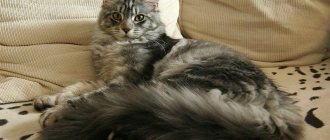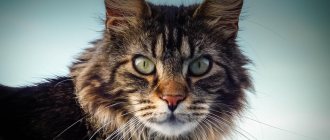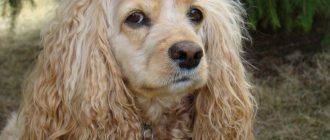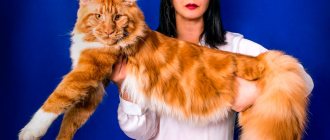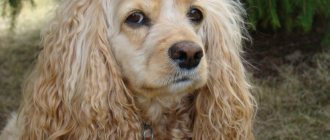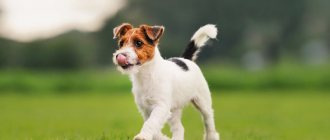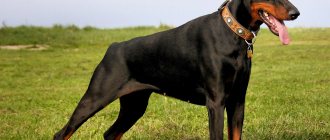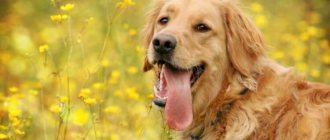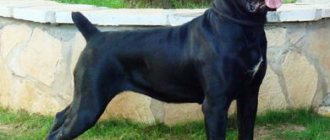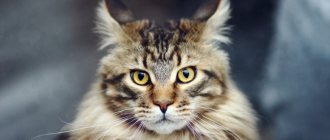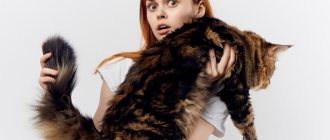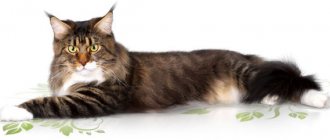For many years, Maine Coons were considered the largest representatives of the cat breeds. Despite the fact that new large pets have appeared in felinology, this breed still remains very popular all over the world and in our country.
The sizes can be medium, but more often large. Today they are one of the largest cats intended for keeping at home. Despite their impressive size and stern appearance, Maine Coons are very friendly to people, strongly attached to their owner, while maintaining feline dignity and independence.
History of the Maine Coon
There are many mysterious stories about the appearance of amazing long-haired cats with tufts on their ears in one of the states of North America - Maine.
"Kun" means "raccoon". And according to one version, it was the mating of this animal with a wild forest cat that gave birth to a new species. But it is unlikely that this legend has any real roots, since interspecific crossing is impossible.
Another story attributes the participation in the appearance of this animal to the North American lynx. The characteristic tassels on the ears suggest this. But geneticists refute this theory too.
There can be only one correct assumption - this variety occurred as a result of a long natural mutation of some wild aboriginal cat species.
Modern representatives of the breed come from Manx cats, which were valued by peasants for their excellent hunting qualities. These large animals coped well with protecting homes, barns and food warehouses, destroying various rodents.
Cat shows are fun that were invented quite a long time ago, and at one of them a cat was presented, which today is considered to be the first representative of the breed.
It was a huge, fluffy handsome man named Captain Jenks from the naval cavalry. It was shown at several exhibitions in the United States in 1861, after which representatives of this breed became very popular.
At the beginning of the 20th century, popularity began to wane; Maine Coons gave way to other cats and could have disappeared completely. This breed was saved by the same peasants and farmers who continued to breed excellent mousecatchers to protect their possessions from rodents.
Reviews from owners and veterinarians
Most future Maine Coon owners first study the opinions of people who have dealt with this breed. We hasten to inform you that almost all the reviews are positive, and many recommend getting a similar pet.
Inga, owner:
“I have been looking after my Maine coon for 5 years. I raised the cat from childhood, taught her like a child, because she is very smart and smart. Now my pupil gives what she deserves - her love and affection. He always tries to seize the moment to sit in my arms and purr. She is also very cunning. She knows how to beg for treats, she will sit down and silently hypnotize her for a long time until I feed her.”
Ekaterina, veterinarian:
“Many people are afraid of such an unusually large cat and may perceive it as a dangerous predator, but this is not so. Almost all of our Maine Coon visitors are always friendly and calmly perceive others. This applies not only to people, but also to other animals. They always have a special interest in dogs. Makecoon owners are not frequent visitors, because this breed really has a strong immune system, which has been instilled in it since childhood.”
Victoria, owner:
“I have a couple, the cat is big, of course, but the cat surpassed her almost twice. These are unusually huge animals that eat a lot accordingly). Therefore, I try to feed both dry food and natural products, because you can’t get enough of semi-finished products. Despite their size, the house is quiet; after all, these are cats, not elephants. I also want to note their cleanliness, they are very neat. They are easy to train and do not show aggression.”
Appearance description
The Maine Coon looks like a very large cat. But only some representatives of the breed reach great weight. For the most part, this impression is created due to the pet’s long and voluminous fur. The maximum weight of a female individual rarely reaches seven kg, and that of a male - nine. Although this breed is still considered large.
Maine Coon cats can reach a height of 0.4 meters, and a length (taking into account the length of their rather large tail) - 1.2 meters.
Maine Coons develop very slowly. This is the only breed in which maximum weight and body length are formed only at four years of age. From this period they are considered to have reached sexual maturity.
Distinctive features are not only large dimensions, but also cute tufts on the ears, powerful clawed paws with fur growing between the toes, and a luxurious fluffy tail.
Let's look at the standards of this breed:
- the head is quite large, longer than wide, the cheekbones are located relatively high;
- the muzzle is blunt, proportionally located on the head; in profile, such cats do not have an elongated narrow muzzle;
- the ears are quite large, gradually narrowing towards the top, covered with hair, ending in small tassels, located high, with a distance between them approximately equal to the width of the lower part of one ear;
- oval-shaped eyes, the iris can be any color, including blue (in cats that are white or have white spots);
- the Maine Coon's body is distinguished by proportionality, pronounced muscles, strong bones, a wide chest, limbs proportional to size;
- the limbs are straight, the paws are wide, with hair between the toes (there are five toes on the front legs, and four on the hind legs);
- the tail is long (up to 35-37 cm), wide, covered with long hair, straight, wide at the base, tapering towards the tip;
- thick, dense wool, silky to the touch, lengthens on the stomach, forming “pants”, the hair is shorter on the shoulders and chest, and a “collar” on the neck.
If the Maine Coon's coat is short or does not lengthen on the belly and hind legs, this is considered a fault in the breed.
Maine Coon colors are numerous and varied. These can be either solid colors of any color or mixed colors - bicolors, tabbies, torties.
Despite the fact that the natural species had only two shades of wool - black and red, as a result of numerous selections and mutations, the color range became much wider. Nowadays there are Mien Coons of cream, graphite, gray, blue, red, and white colors.
At shows, lavender, Himalayan and chocolate colors are a deviation from the standard and cause for disqualification.
Body
The Maine Coon is the largest of the domestic cats. The average weight of an adult Maine Coon is 6-8 kg. Cats reach 9-10 kg; exceeding this parameter, as a rule, indicates that the handsome furry cat is obese. The body length of an adult is up to 135 cm, the height at the withers is from 25 to 45 cm, which is comparable to a fairly large dog. Cats are smaller than cats and more gracefully built. See also photos of an adult Maine Coon.
The build is dense, moderately stocky. The body is elongated horizontally, the silhouette has a rectangular outline. This breed has heavy bones and well-developed, trained muscles. Thanks to excellent muscle tone, the body radiates a feeling of strength and power.
The neck is solid, of medium length, looking like a strong pillar. As a rule, the neck is framed by a magnificent thick collar. The sternum is wide and powerful. The paws are strong, strong, proportional to the body. The feet are large, rounded, and bushy hair grows between the toes.
The tail is longer than average, normally reaching to the animal's shoulder or more. Covered with silky flowing strands. The root of the tail is thickened, closer to its end the tail becomes thinner. The outline of the tail resembles a fan.
Subtle physique, fragile bones, long legs, bob tail, as well as excessive stockiness and “squareness” of the body do not meet the standard, which means they are fined during the evaluation of the animal.
Character and habits
Maine Coons, for the most part, are friendly, sociable and have a high degree of attachment to the owner and all household members.
Despite the fact that the appearance with a heavy lower jaw creates the impression of isolation and a difficult character, the temperament of these giants is actually peaceful and affectionate.
Cats of this breed need communication, and from childhood they need to be given a lot of attention. Character can be corrected; cats are well-educated if the process is started at an early age.
Also read the article about the most affectionate cat breeds.
Maine Coons love communication, especially with people, but they also find a common language with other representatives of the animal world, if they are not in conflict. They love attention and love to be petted. Due to natural curiosity and inquisitiveness, they quite easily make contact with unfamiliar people and animals. This trait is especially characteristic of males; cats are more cautious and distrustful.
As a rule, the Maine Coon is a fairly independent animal that will not particularly bother its owner by hanging around under his feet. But some cats love to demand attention and can be somewhat intrusive. However, for a loving owner this disadvantage is not so great.
Representatives of this breed, as a rule, become attached to one person, who is considered the owner, but they also show friendliness to other family members. The love and loyalty of Maine Coons is often compared to that of a dog, and this is true: they love their owners very much.
Typically, cats are attached to their home, but representatives of this breed easily adapt to any environment, as long as their loved one is nearby.
Another feature of the Maine Coon is its love for walks. These cats are very curious and enjoy being outside.
If you accustom your pet to a harness and leash from early childhood, then he will not experience discomfort while walking “on a leash,” as long as the leash is long enough and allows him to explore as many interesting places as possible from a cat’s point of view.
Preparing for the arrival of a Maine Coon kitten at home
A novice owner needs to familiarize himself in advance with the features of keeping an elite Maine Coon:
- Allocate space for your pet to relax and play – the entertainment area of a big cat should be spacious.
- It is necessary to take care of products for caring for your pet’s fur; it is necessary to accustom your Maine Coon to combing from the first days of acquaintance.
- Find a secluded place for the toilet tray.
- Buy suitable toys for your cat - little Maine Coons love to run after a wind-up mouse or jump for a wand with feathers.
This is interesting! As a child, the Maine Coon most strongly demonstrates the nature of its freedom-loving ancestors. A representative of this breed instinctively learns to hide, sneak up and suddenly attack, and catch prey, although this skill will not be useful to him in later life.
Features of maintenance and care
The Maine Coon is a large, strong and active cat, and this must be taken into account when planning to purchase a pet of this breed. These cats need space, they like to explore high places in the apartment and play actively.
The best option would be a special corner for cats, with platforms of varying heights and a house.
If the cat does not exercise enough, this will lead to obesity and various diseases, which will negatively affect life expectancy.
In the absence of a special corner, you can equip a bookshelf for your pet, hanging it on the wall, or a chair intended only for it. It is important for the Maine Coon to know that he has a personal space that he can inhabit as he pleases (although cat owners know that he usually considers the entire apartment to be such space).
When getting a pet, every person should remember that he needs attention and care, then he will live long and happily. In order for the animal to be healthy, it is necessary to regularly show it to the veterinarian for medical examination.
In addition, the mustachioed friend needs vaccination.
The first vaccination is given at the age of two months; it develops complex immunity to viral infections, chlamydia, tracheitis and pylencopenia. The following are done according to the schedule recommended by the veterinarian (there are special instructions that indicate the approximate vaccination schedule). It is developed taking into account not to overload the animal’s body with drugs, but also in such a way that by the age of teething (when the immune system is significantly weakened) the necessary protection is formed.
The second vaccination is given to the cat at approximately three months of age; it must be vaccinated against rabies. The next procedure is per year, and then annually or as necessary. 10 days before vaccination, the kitten must take a course of antihelminthic medications.
Immediately before vaccination, the cat will be examined by a veterinarian, since the procedure can only be performed on a completely healthy animal.
To improve your pet’s immune status, the health of its eyes, fur, teeth, and musculoskeletal system, you should regularly give it vitamin complexes. It is better to select them together with a veterinarian. He will advise which vitamins are most suitable for a particular cat.
Antiparasitic drugs must be given in courses, regularly. It is also necessary to regularly treat for fleas and ticks. All these measures are especially necessary for Maine Coons who walk outside.
Representatives of the breed are very clean, constantly washing themselves and licking their fur. It accumulates in lumps in the stomach and is periodically regurgitated naturally. But if the owner wants to take care of the health of the furry pet, then the animal should be given special pastes that help remove hairballs from the gastrointestinal tract.
In some cases, hairballs are so large that they can block the intestinal lumen, causing obstruction. This is a dangerous condition, so it is better to take care of hair removal in advance.
In order to improve digestion, felinologists also recommend purchasing special pots of weed or growing it at home yourself. Cats nibble grass, which helps cleanse their intestines better.
Maine Coons have luxurious thick hair, which in natural conditions helped them easily endure the rather harsh climate of their homeland. A cat living at home needs help in caring for his luxurious fur coat. The animal should be combed 1-2 times a week, and during the molting period - even more often, daily. It doesn't take much time, and many cats even really like the procedure.
For combing, a natural bristle brush or a fine-toothed comb with a metal base is suitable. Long, thick hair can become tangled, especially if brushing is not done regularly. You can try to carefully separate the matted wool with your fingers, and if that doesn’t work, then cut it off.
Most often, Maine Coon hair falls off on its “pants.” In order not to cause discomfort and pain to your pet, before combing it is necessary to check for the presence of tangles.
You should bathe regularly, using special shampoos and conditioners. A special feature of this breed is a noticeable love for these procedures: many of them love to play with a trickle of water, splash around, drink from the tap and even take a full bath. Because of this feature, they tolerate the washing procedure quite easily and even with pleasure.
Before bathing your pet, you need to make sure that water does not get into its large ears. To do this, you need to protect them with cotton swabs.
Caring for a cat of this breed also includes regular cleaning of the ears with a special solution, teeth and claw trimming. You can do all these procedures yourself, or you can take your pet to a groomer and veterinarian.
Features of caring for a Maine Coon kitten
Maine Coon kittens, which are purchased from a nursery at the age of 3 months, already have initial socialization skills, know how to eat and go to the toilet correctly. In this case, the pet's training process is simplified, and the animal's introduction to its new home must be carried out according to the breeder's recommendations.
You cannot suddenly change the rules of behavior of a young cat; its innate instincts will not allow it to quickly adapt.
Caring for Maine Coon kittens involves gradually and unobtrusively introducing them to an unusual environment. The owner must spend a lot of time with the pet and participate in games.
Feeding
The Maine Coon does not require a particularly special diet, but it is important to consider that it is a large and active animal. Nutrition should be complete and varied, including all the vitamins and microelements necessary for the animal. Experts do not give clear recommendations regarding whether to give dry or canned food to your pet.
As a rule, it is advised to feed mostly dry food, and offer canned food several times a week. All quality cat food manufacturers have special lines designed specifically to meet the needs of large cats. So they are suitable for Maine Coon.
In any case, homemade food is not suitable for Maine Coons, although some owners prefer to feed their pets this way.
You can give your cat natural food, but then you need to carefully select his diet. About three quarters should be various types of meat, and only a quarter should be milk and dairy products, seafood, eggs, and vegetables. With such a diet, it is important to give your pet vitamin and mineral supplements to its food.
Food specially produced for cats contains the substances necessary for the animal; high-quality dry food is an excellent prevention of tartar. Breeders recommend choosing dry food and canned food, the main component of which is some kind of meat.
For Maine Coons, food based on any grain crops is contraindicated, since genetically these cats are not predisposed to digest them. This is due to the fact that in natural conditions their ancestors never ate grain, and such feeding can cause various diseases in the pet, in particular diabetes or obesity.
It is not recommended to mix natural food and specially produced food, and you should not constantly change them or use several brands at once. It is better to accustom your pet to the diet of one manufacturer from childhood and not to use others unless absolutely necessary.
Dishes intended for the animal are important. It is best to purchase metal or glass bowls. This can be dishes made from any natural material, but not plastic.
Plastic feeders can cause allergies and other unpleasant ailments.
How and what to feed a Maine Coon cat
A nutritious diet plays an important role in a cat’s development. In order for the kitten to grow up healthy, you need to follow the recommendations of experts regarding feeding the Maine Coon.
During this period, it is necessary to determine the feeding option - leave the cat on regular food or switch it to industrial food. Every decision has positive and negative sides.
The first method will require increased financial costs, taking into account the individual characteristics of the breed in maintenance.
Dry or wet industrial products for feeding the Maine Coon are selected according to the recommendations of the manufacturers and the prescriptions of veterinarians for a specific breed of cat.
Important! Unlike other breeds, the Maine Coon is fully formed only by the age of 3-4 years. Before this period, the cat grows up, and a person needs to take this circumstance into account when organizing the diet of a furry pet.
Health
Maine Coons are distinguished by excellent health, which is due to their origin and genetic adaptation to survival in the harsh conditions of long winters.
According to statistics, the life expectancy of representatives of this breed is 13 years or more. More than half of the cats recorded live for more than 16.5 years.
The most serious health problems in Maine Coons are the same as in humans - diseases of the cardiovascular system.
Hypertrophic cardiomyopathy is the most common pathology in cats, including representatives of this breed.
As a rule, this disease affects cats of middle and old age, so it is important to monitor the health of your pet and regularly show it to the veterinarian, since with timely diagnosis the disease can be corrected.
Another problem that can arise in this breed is spinal muscular atrophy. This pathology is also inherited by cats in an autosomal recessive manner and is characterized by damage to the nerve fibers of the spinal cord responsible for the innervation of the muscles of the skeleton and limbs. This disease manifests itself early in kittens, as early as three or four months of age.
The disease prevents the animal from jumping high, but in general these babies eat well, play well and can live well for a long time, like all other cats.
The musculoskeletal system of a pet of this breed can be affected by a disease such as hip dysplasia. This is also a hereditary disease, which most often manifests itself in old age, mainly in males: they begin to suffer from arthritis and limp. Maine Coons can also get sick with another genetically determined disease - polycystic kidney disease.
In general, the likelihood of serious illnesses in representatives of this breed is quite low: they have excellent heredity, since the health of Maine Coons was formed through natural selection, and not selection.
Issues of raising and training Maine Coon cats
Observing daily behavior helps a person better understand the animal. This method is used in training - the easiest way is to teach a cat to do exactly what is inherent in its nature.
The habits of the Maine Coon cannot be called exclusively cat-like. Generations of wild ancestors and natural selection have led to the breed being credited with canine “manners.” For example, sometimes Maine Coons are ready to bring slippers or a newspaper to a person, unlike ordinary cats.
In the process of raising a pet, you cannot use force - it will become stubborn and will not obey its owner. And given the height and weight of a big cat, its pranks can be destructive for others.
Important! Raising cats of any breed is best done through play, reinforcing reflexes and actions in it. Even a change in voice intonation can show the animal the owner’s dissatisfaction and change its behavior.
Cost of a kitten
A kitten of this breed is quite an expensive pleasure. Prices vary greatly depending on the purpose for which the pet is purchased: for exhibitions, breeding, or, as they say, “for the sofa.”
Kittens that meet the breed standard are usually purchased in order to be bred and shown at various competitions. The cost of such individuals starts from 100 thousand rubles, and this is far from the limit. The price is determined by the breeders themselves, and may vary depending on the region.
Kittens that have any deviations from the standards are cheaper, but also not cheap - about 60 thousand rubles. Such a cat will not be accepted for an exhibition and is not suitable for breeding, but this does not mean that he cannot become a wonderful friend, companion and favorite of the whole family.
Photo gallery of Maine Coons:
How to take care of your Maine Coon's gray coat?
There is no doubt that the fluffy and thick fur of Maine Coons is one of their decorations. To ensure that your animal’s hair does not lose its shine, you should remember the following:
- For health in general and an attractive coat in particular, Maine Coons need proper nutrition. Dry or canned ready-made food labeled “for Maine Coons” (or “for large cats”) of super-premium quality (or holistic) is suitable as a diet. As an alternative to store-bought food, natural food is often chosen, which includes lean meat, cereals, vegetables (greens and fruits, if the cat likes them), and sour milk products. If the animal eats the food that the owner prepares for it, you will have to think about fortification. A lack of vitamins E and B always contributes to the deterioration of the coat;
- Almost any disease makes a luxurious fur coat faded and ugly. Stress, invasive diseases, poisoning, skin diseases are just some of the reasons why the fur looks untidy. To understand that an animal is unhealthy, sometimes it is enough to look at its fur;
- Maine Coons are naturally clean cats, so you shouldn’t bathe them often. As a rule, bath procedures are carried out once every 3-6 months using a special shampoo for long-haired cats, after which the pets are dried with towels and a hairdryer. Show cats are bathed more often, before each appearance. In this case, not only cleansing shampoo is used, but also coloring, degreasing and texturizing grooming products;
- Domestic gray Maine Coons are brushed two to three times a week, and daily during shedding. For the fur on the body, brushes with long teeth are used, for the face and limbs - with short ones. Sometimes they do it differently: first they comb the cat with a brush with sparse teeth, and then with frequent ones. It’s hardly worth neglecting combing, because thick fur will quickly form tangles that will simply have to be cut out, depriving the animal of hair growth;
- During shedding, gray Maine Coons lose hair no less than other long-haired cats. Typically, the fur begins to shed twice a year, usually in early spring and late summer or fall. If the air in the room is too dry, shedding may be prolonged. To prevent the animal from swallowing hair during active hair loss, it makes sense not to neglect combing. And if necessary, you can give the cat a special product - a paste or gel for removing hairballs;
- Sometimes handsome Maine Coons are taken to a grooming salon for a haircut (usually the hair on the body is shortened). On the one hand, after a haircut, it is easier for an animal to survive the heat (especially if there are no cooling devices in the apartment). And the owner has less worries in the form of lengthy combing. However, almost all owners who have carried out a similar procedure at least once note that the new coat that grows is of poorer quality: thinner and more prone to tangling. It turns out that it is better to remove dead hairs with a regular brush, without depriving the Maine Coon of his thick and beautiful coat.
Key facts
The Maine Coon is one of the most unusual and fascinating cat breeds in the modern world. They can be called a lazy breed, although they are not averse to engaging in some active play with other family members.
The description of the Maine Coon breed says that it originated in the USA back in the 19th century. These representatives of pets occupy first place in size among other cat breeds.
This breed is easy to care for, despite its rather long and fluffy coat. It is not necessary to take them for grooming; regular combing at home is also suitable.
The characteristics of the Maine Coon are as follows: they are one of the most affectionate, kind and affectionate. Coons are good with children and other pets, make contact easily and are not afraid of guests. It is worth noting the high intelligence of cats, thanks to which they are easy to train.
Due to their thick and fluffy coat, which repels water, Maine Coons are able to withstand frost. This is also facilitated by the presence of pads that have spring functions and help you move easily through snowdrifts. But at the same time, they can easily withstand very high temperatures, so there is no need to cut the coon for the summer.
Having become interested in something, these felines take a rather amusing and funny pose: they stand on their hind legs and look with surprise on their faces at the object that attracts their attention.
The health and life expectancy of the Maine Coon are high; giant cats can live 14-15 years.
The rarest and most expensive Maine Coon colors
Each breed has rare colors that are not often seen. Maine Coons are no exception. This breed has its own rare shades:
- Brown with spots. These kittens have a color similar to autumn foliage.
- Creamy blue. Looks like tortoiseshell with rare pastel shades.
- Chintz. This is a unique coloring for coons. The base is red, diluted with black tones with white splashes.
- Watered down chintz. There are cream-colored spots on a white background, and blue colors have a solid coloring.
- Spotted with white spots.
Such colors are not typical for coons and are rare.
Smoky
Such cats can be black or blue. The intensity of the haze determines the subspecies:
| Name | Description |
| Chinchilla | Only the tip of the hair is pigmented |
| Shaded | color has a quarter of the hair |
| Smoke | Only the root of the hair is colored white, the main part has black or blue pigments |
| True smoke | Half of the hair has pigmentation |
| Silver | the hair is white at the root, the rest is light silver |
| Cream | at birth, the coat is uniform in color, but gradually becomes unevenly pigmented |
| Classic wild | brindle, marbled black, spotted |
Smoky cats are characterized by white roots. Gray is usually found in monochromatic animals.
Chocolate
The wool is colored brown, warm, rich. The presence of inclusions of other shades or patterns is not allowed. The hairs have an even distribution of pigment. Unlike red tones, it is darker and deeper. Quite rare in breeding. The paw pads and nose also have brown tones.
Classic wild
This color suggests the presence of a pattern on the animal's fur. They can be of different types:
- brindle;
- marble black;
- spotted.
These are the main colors of coons that were common among their wild ancestors.
Peach
These cats have similar features to their cream counterparts. These can be yellow, orange shades characteristic of tabby coons.
Black
Black monochromatic coloring is extremely rare for this breed.
Each black coon has a different color depth and saturation, so it is impossible to find two identical black cats. Usually, this color hides the pattern on the coat. In small kittens it can be difficult to see, but as they grow older it is completely hidden. The cat becomes completely monochrome. An animal with black fur looks regal, luxurious, reminiscent of a majestic panther in appearance.
Black and white
Cats with this coloration have different proportions of these colors:
- Black with white spots. There are several small spots of white on the fur.
- White medallion. A white spot is located on the chest of the animal, reminiscent of decoration.
- White gloves. The cat has black and only white paws of the animal.
- White tuxedo. There is a white shirtfront on the neck, and the paws are also white.
- Bicolor. Black and white in a 1/1 ratio.
- Harlequin. The color is predominantly white with a few black spots.
- Wang. The head and tail are painted black. The rest of the body is white.
What is the danger of white color
White Coons have a predisposition to complete deafness.
It is found in this color much more often than in animals with a different shade of fur. However, there is no need to be upset by this fact. Deaf individuals feel great.
They live well in the house, and are oriented to the area no worse than healthy ones. Their hearing loss is compensated by vision and a keen sense of smell. People who do not know about cat deafness will not guess about it.
Cream
This shade is obtained by lightening the red. The animals are colored in shades similar to raw ginger. When crossing, individuals with genetically weakly expressed pigment in the pedigree are preferred. However, theoretically, even Black Solid Maine Coons can produce cream-colored offspring.
Tips for choosing a kitten
First of all, you should find out as much information as possible about nurseries and breed standards. This is especially important for those who are going to buy a show-class kitten and participate in exhibitions with it. All information can be found on TICA, WCF, CFA felinological systems.
Of course, it is important to decide on the gender and class of the animal you are purchasing, and also decide which branch you will choose. There are two of them: American and European. The first is distinguished by thick hair, wide and obliquely set eyes and larger sizes than the second. Europeans are relatively miniature, their fur is not so thick and long, but at the same time the “lynx tassels” are more pronounced.
After 12-15 weeks, you can purchase a kitten and take it to your home. If you purchase an animal from a good nursery, they will definitely tell you about each kitten and litter. The animal will be vaccinated according to age, branded, and all pets from the litter will be toilet trained and scratching posts.
If you see that the kitten is inactive, lies down all the time, and looks lethargic, then this is a clear sign of an unhealthy animal.
Ask the breeder to introduce you to one of his parents. By the behavior of the mother or father, you can easily determine the temperament of the future pet. Also, an experienced breeder will definitely give you food and filler for the first time, which the kitten has been accustomed to since birth. It is possible that your favorite toy will go with you, which will help the animal adapt more easily to new conditions. It is recommended to purchase Maine Coon kittens from nurseries so that you do not later discover any defects in your pet or raise a completely different breed instead of a Maine cat.
Features of feeding and diet
Your pet's diet should include all the following:
- proteins are essential components for ensuring the good functioning of all organs, for growth and well-being;
- carbohydrates are a source of energy;
- fats are a source of energy and a component for the formation of immunity;
- vitamins and minerals.
The most important thing in purchased food is the presence of a meat ingredient in the composition in the first place. It should not contain many preservatives (it is better if they are absent altogether), so it is advisable to buy food from professional brands.
As for homemade food, the majority should be meat products: chicken, turkey, beef. You can also include cereals, vegetables, low-fat dairy products, and eggs in your diet. In pet stores you can buy a special grass - sprouted grain crops.
When choosing a diet, you should take into account the size of cats, because they are very different from other breeds. If this is your first time, consult your veterinarian or breeder for advice.
History of the origin of the breed
In the vastness of our country, a similar breed appeared quite recently, about 20 years ago or a little more. This happened when the well-known “Iron Curtain” fell and a mass of different, hitherto unknown breeds of cats and dogs headed towards us. The Maine Coon breed was no exception.
Interesting to know! If you believe the legend, then at one time there was a Captain Kun who preferred to travel with large long-haired cats. During the next voyage, some cats ran away from the deck of the ship, which contributed to the appearance of Maine Coons in various countries.
According to some information, the breed was first shown at an exhibition in Boston, after which the breed was forgotten for a long time, and undeservedly.
And yet, English farmers made a lot of efforts to preserve this amazing breed, which, in its breed characteristics, pointed to the American raccoon cat. Several decades ago, on the Isle of Man, which belongs to the English kingdom, a special coin was issued dedicated to the Maine Coon cat breed.
